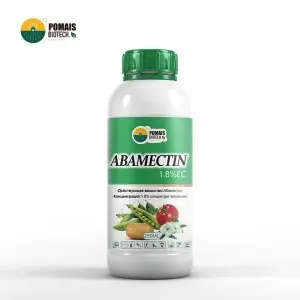How Does Abamectin Work?
Abamectin is a potent insecticide and acaricide derived from avermectins, a group of natural compounds produced by the soil bacterium Streptomyces avermitilis. It is widely used to control insects and mites in agricultural, horticultural, and veterinary applications. Abamectin primarily affects the nervous system of target pests, leading to paralysis and death.
Related reading: Abamectin vs Ivermectin: Insect and Parasite Control
1. Mode of Action
Abamectin works by interfering with the target pest’s nervous system. Specifically, it binds to glutamate-gated chloride channels (GluCls) in nerve and muscle cells, which are vital for maintaining the proper flow of chloride ions. This process has two key steps:
a) Activation of Chloride Channels
- Glutamate-Gated Chloride Channels (GluCls): These channels are essential for the normal functioning of nerve cells in invertebrates (such as insects and mites). Abamectin binds to these channels, which leads to an increase in the influx of chloride ions into the nerve cells.
- Chloride Ion Influx: When abamectin binds to the glutamate-gated chloride channels, it causes them to remain open for a prolonged period, allowing an excessive influx of chloride ions into the nerve and muscle cells. This hyperpolarizes the nerve cells, making them less responsive to stimulation.
b) Disruption of Neural Activity
- Nerve Signal Disruption: The excessive chloride ion influx hyperpolarizes the nerve cells, preventing them from transmitting signals properly. The hyperpolarization effectively paralyzes the nervous system by blocking communication between nerves and muscles.
- Muscle Paralysis and Death: Since the nerve cells are unable to transmit signals, the muscles of the pest (including respiratory muscles) cannot contract. This results in paralysis, followed by the death of the pest through starvation or respiratory failure.
2. Target Pests
Abamectin is effective against a variety of arthropods, including:
- Insects: Leafminers, thrips, whiteflies, aphids, and psyllids.
- Mites: Spider mites, particularly the two-spotted spider mite and rust mites.
- Other Pests: Abamectin is sometimes used to control pests like fire ants and other soil-dwelling pests in specific applications.
The action of abamectin is primarily systemic in some cases and contact-based in others:
- Systemic Action in Plants: When applied to plants, abamectin is absorbed by the foliage and translocated within the plant, providing protection against insects that feed on treated parts. However, it has limited systemic movement compared to other systemic insecticides.
- Contact and Ingestion: Pests are typically affected by direct contact with abamectin sprays or by ingesting treated plant tissue. Once exposed, the pest quickly stops feeding due to paralysis and eventually dies.
3. Slow Action and Persistence
While abamectin quickly causes paralysis in the target pest, death can take several days. This delay is due to the gradual paralysis of the pest’s muscles and feeding systems. Despite this slower kill time, abamectin is effective because the pest stops feeding shortly after exposure, preventing further crop damage.
4. Selective Toxicity
Abamectin has selective toxicity:
- Higher Toxicity to Invertebrates: It is highly toxic to invertebrates like mites and insects but much less harmful to mammals and birds because mammals do not have the same glutamate-gated chloride channels in their nervous systems.
- Low Mammalian Toxicity: While abamectin is highly effective against invertebrates, it has low toxicity to mammals when used according to the label. This makes it safer for use in agricultural and veterinary contexts, though precautions should still be followed to avoid overexposure.
5. Applications of Abamectin
Abamectin is used in various sectors:
a) Agriculture
- Crop Protection: Abamectin is applied to a wide range of crops, including vegetables, fruits, nuts, and ornamental plants, to control mites and insects. It is particularly effective against spider mites, leafminers, and thrips.
- Foliar Application: Abamectin is applied as a foliar spray, and pests ingest it through feeding on treated plant surfaces. The systemic properties allow some absorption and movement within the plant.
- Low Residue: Abamectin breaks down quickly in the environment, leaving low residues on crops, making it suitable for use close to harvest time.
b) Horticulture
- Ornamental Plants: Abamectin is used to protect ornamental plants from mites and leafminers. It is particularly valuable in greenhouse settings, where pests like spider mites can rapidly damage plants.
c) Veterinary Use
- Livestock: In veterinary medicine, abamectin is used to control mites and lice on livestock like cattle and sheep. It is applied as a pour-on or injectable formulation to treat parasitic infestations.
- Companion Animals: While abamectin is less common for use in companion animals, it is sometimes used in specific formulations for controlling mites in dogs and other animals.
Key Properties of Abamectin
| Feature | Details |
|---|---|
| Target Pests | Mites, insects (leafminers, thrips, whiteflies, aphids), and fire ants |
| Mode of Action | Disrupts nerve activity by opening glutamate-gated chloride channels |
| Effect on Pests | Causes paralysis and death (pest stops feeding shortly after exposure) |
| Systemic Movement | Limited systemic movement in plants |
| Toxicity | Highly toxic to invertebrates; low toxicity to mammals and birds |
| Time to Kill | Gradual kill (death occurs in 2-4 days) |
| Formulations | Available as foliar sprays, soil treatments, and veterinary products |
Conclusion
Abamectin is a highly effective insecticide and acaricide, used primarily to control mites and small insects in agriculture and horticulture. It works by disrupting the nervous system of pests, causing paralysis and eventual death. While it takes several days to kill the target pests, abamectin provides rapid cessation of feeding, preventing further crop damage. Its selective toxicity makes it a valuable tool for pest management, with minimal impact on non-target organisms, including mammals. However, proper application is essential to ensure its effectiveness and avoid resistance development in pest populations.
Post time: Sep-29-2024




